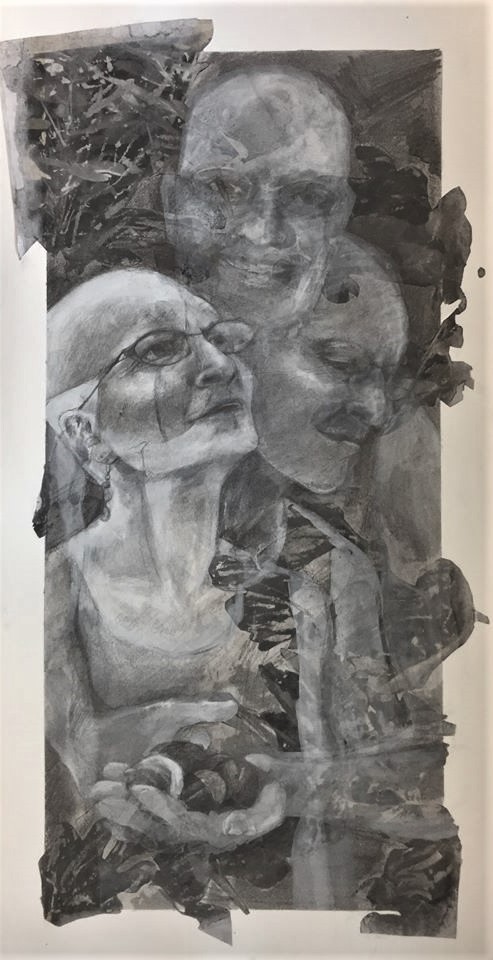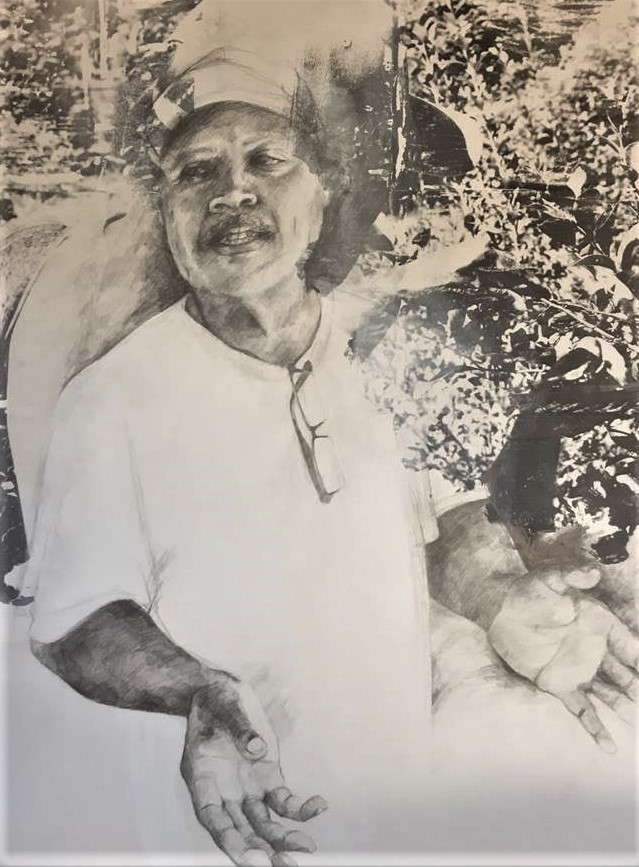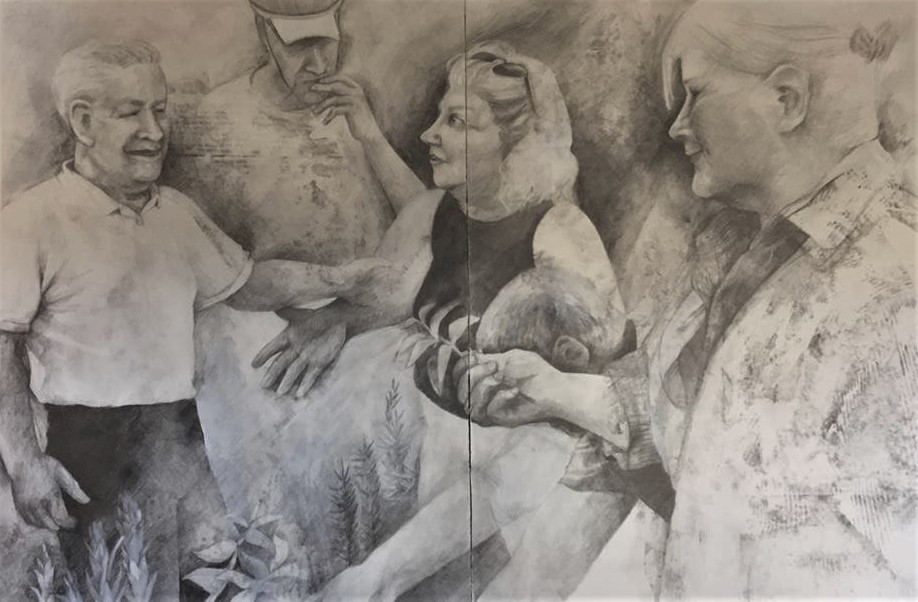“FROM THE SAME SOIL”
This new portraiture series by art/ biology student Shannon Bodeau is part of a Climate Listening Project + McCullough Fellowship + University of North Carolina Asheville collaboration. Shannon listened to community members and created hand-drawn graphite and charcoal portraits to share their climate stories as part of her college thesis.
How does connecting to the earth connect us to each other?
We are in awe of Shannon’s art and inspired by each of these individuals. The Climate Listening Project hopes these stories inspire you and others to share your stories through your own skills – your contribution is an important climate solution.
Credits:
Artist: Shannon Bodeau
Adviser: Dayna Reggero, Climate Listening Project


 “Isa”
“Isa”
“Ultimately, when you love nature and the earth, you love the folks that walk on it.”
“Really, in case there’s a natural disaster where we can’t get food trucks in, or the grocery store is not able to operate, and that’s not an option to get food, and restaurants aren’t an option to get food… And, y’know, what are we going to do? How are we going to make sure that we can all still be a community without saying ‘oh I have to go get what’s mine’ and causing more chaos in the world? How are we all going to be in union and be like ‘OK, we’ve thought about this, we’ve planned for this.’ We have options, we have community gardens, and there’s other farms, there’s other land that people have which we’ve been maintaining. We have all these different options where people can access food. That’s kind of the big end goal with urban agriculture and trying to be food sovereign. You want to have a system that all plays in together, where as human beings, if it ever comes down to it, we can all choose to exist together and have food options.”


 “Heather”
“Heather”
“I used to know the seasons, but I didn’t watch them. Now I watch them for all the things that could affect life.”
“I think one of the lessons I’ve learned from gardening is acceptance. Oh, like, this damn alopecia is not what I would want on anybody, but I have to accept it. In the fall, if you get a lot of rain, you got a lot of rain. If all of a sudden it’s hot and dry, hopefully your rain barrels are full. A frost comes early, a frost comes late, this pear gets hit with a frost and I don’t get any pears this year. So gardening is a lot about acceptance of this thing that’s bigger than you are. I think so much of it is about letting go, and accepting that this is what it is this year, and next year it might be different.”


 “Mr. Harris”
“Mr. Harris”
“A garden is about changing people’s ideas about what can happen and when it can happen, and bringing social pride in our neighborhood.”
“I grew up in Hyde County, North Carolina, in the 1950s. The place I grew up was in a small farming village, and when I say ‘farming village,’ not a lot of African Americans are farming there anymore. But my father had a mule for doing the small farm out back of his house. By the time I got out of high school, I took my father to the side of the garden and said ‘I ain’t doing this no more. I’m out of here. I’m headed off to college to become an engineer.’ And he just looked at me and said ‘take care of yourself.’ So off to college I went, graduated, and then went off into the corporate world as an manufacturing engineer. I stayed in the corporate world working for, basically, Fortune 500 companies for the next 47 years. Out in college and the corporate world, I never really thought about gardening. The further and further I got away from being any part of the land, I would think ‘I’m an engineer, I don’t have to do this anymore.’ But I went back and forth on occasion, and I’d do farm chores to earn money for school. And I can still remember my dad smiling at me and saying ‘take care of yourself.’ He knew I was going to come back. And then about four years ago, I joined a committee to get a grocery store in what they call the Southside. This neighborhood is under attack from gentrification. A good garden in a good location serves people in that location. It’s one of the greatest things a community can have, because it brings people together for the common cause of producing food. And that’s good.”


 “Roots”
“Roots”
“My grandma says that it brings her a lot of joy to plant something and then to see it coming to fruition, and to see it bringing joy to other people.”
“I grew up in a lot more city environment than my parents, my aunts and uncles, and especially my grandparents. But being in touch with nature, it made me feel connected with all of them, especially since I had this whole family system that was uprooted from somewhere far away. Where we’re from in Brazil, you don’t knock on people’s doors, you clap. My grandma really likes orchids, and she plants them on trees around her house. Sometimes she’ll see an orchid blooming and she’ll put it out by the front of the house, and she’ll specifically place it in a way that people can see it from the gate. That way, if someone’s having a bad day they’ll see the flower. So sometimes people will clap and be like ‘oh it would be so cool if I could get a cutting of that plant of one of those fruit!’ I remember that from when I was very little, my cousins and I would be playing outside and random people would start clapping from the gate and my grandma would come and they would ask her about the fruit trees. And she would share with them. My grandma also has this plant called the rainbow eucalyptus. When its bark peels off, it’s every color of the rainbow. That’s the plant she told me about when I came out to everyone! I was so scared she was going to be angry at me, but then she just spent forty minutes talking about this plant. It was a good day. Looking at the roots of a plant makes me think of a family. The parents are like the roots, and they grow forward and forward so the family spreads out like the leaves and flowers and branches.”


 “Elder and Sage”
“Elder and Sage”
“I think gardening is a salvation for us to reconnect with ourselves and the earth.”
“Front porches had a function, not only to stay cool in the summer heat, but as a way of continuing your sense of belonging and not being isolated. The people who live in these senior apartments were isolated, and we needed a place to come down and sit, where we could interact not only with one another, but also with people passing through. This neighborhood is no longer somewhere people just walk through to go somewhere else. I like the garden because it is relaxing. It keeps my blood pressure down! And I like to cook, so I get things to cook from here. I have my hot peppers here. It’s beautiful to see how from nothing, you have flowers, and you bring the people from the neighborhood. It’s a nice feeling to bring them together. It’s like, you’re on a mission every day to see what is going on. The majority of us live in the apartments around here, though anyone can come help. It’s mostly people who are landless, and want to reconnect with the earth. What makes us unique is that we’re strategic about our place in the urban center. People love to see it. It’s almost an anomaly to see a growing thing here. And we’re building a community again, with the bees and the flies, and the plants. It’s such an important community project. This whole green area here should be a big, beautiful part of downtown. This garden could be the first step.”